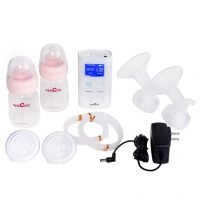Returning to work while breastfeeding can be a challenging and rewarding experience for moms. Success requires careful planning, support, and understanding from both employers and colleagues. Familiarize yourself with your company’s policies and benefits related to breastfeeding support, and be aware of your rights and the benefits available to you as a breastfeeding mom. In the United States, legal protections such as the PUMP (Provide Urgent Maternal Protections) Act, which took effect April 28, 2023, mandate employers to provide reasonable break time and a private space for expressing milk. Military moms can also benefit from the protections offered by Army Regulation (AR) 600-20, Army Command Policy and The Uniformed Services Employment and Reemployment Rights Act (USERRA).
Planning ahead
Consider your ideal timeline for returning to work early in your breastfeeding journey so you have plenty of time for a smooth transition. If possible, start by creating a breastfeeding plan in collaboration with your employer. The plan should outline your needs, schedule for pumping breaks, and any necessary accommodations. Discussing options for flexible work arrangements, such as remote work or adjusted schedules, can also help you find a balance between work and breastfeeding. Effective communication with your supervisor can lead to a supportive environment conducive to your breastfeeding journey, so address your concerns about privacy and pumping at work early, often, and clearly.
Building a support system
Surrounding yourself with a strong support system is vital for success. Engage with colleagues and managers who can offer understanding and support. Seeking support from other working moms, including military moms, can provide valuable insights and encouragement. Join online communities, forums, and social media groups specifically designed for breastfeeding moms to connect with others who share similar experiences.
Pumping strategies for the workplace
Choose the best pump for your circumstances.
Selecting the right breast pump is an important decision that can greatly impact your breastfeeding experience as a working mom. It’s crucial to choose a breast pump that suits your specific needs and aligns with your work environment. Here are some factors to consider when making this important choice:
- Pump Type: There are two main types of breast pumps: electric and manual. Electric pumps are powered by electricity or batteries, offering convenience and efficiency. These are ideal for moms who need to pump frequently or have limited time. On the other hand, manual pumps rely on hand-operated suction and are suitable for occasional use or situations where electricity is not readily available.
- Portability: Consider the portability of the breast pump, especially if you anticipate pumping outside of your home or in different locations at work. Some pumps are lightweight and compact, making them easy to carry in a bag or tote. Portable pumps provide flexibility and convenience for working moms who need to pump on the go or during their commute.
- Noise Level: Depending on your work environment and personal preferences, the noise level of a breast pump can be a significant factor. If you work in a quiet office or shared space, you may prefer a pump that operates quietly or offers a “whisper mode” for discreet pumping. Noise reduction features can make your pumping sessions more comfortable and private.
- Suction Strength and Adjustability: Every mom’s milk supply and comfort level are unique, so having a breast pump with adjustable suction settings can make a difference. Look for pumps that offer different levels of suction strength, allowing you to customize the pumping experience to your comfort. Being able to adjust the suction can also help stimulate milk flow and maximize milk expression.
- Double Pumping Capability: Double pumping, which involves expressing milk from both breasts simultaneously, can significantly reduce pumping time while increasing milk production. Many breast pumps offer double pumping functionality, allowing you to save time and maintain milk supply efficiently. This feature can be especially beneficial for working moms with busy schedules.
- Ease of Cleaning and Assembly: Consider the ease of cleaning and assembling the breast pump. Look for pumps with few parts and components that are dishwasher-safe or easy to clean with minimal effort. This will simplify your pumping routine and ensure hygiene.
- Compatibility with Pumping Accessories: Check if the breast pump you’re considering is compatible with additional pumping accessories such as hands-free pumping bras, different flange sizes, or milk storage bags. These accessories can enhance your pumping experience and make it more comfortable and efficient.
Establish a pumping routine is key to maintaining a healthy milk supply.
Establishing a pumping routine will help you maintain a healthy milk supply as a working breastfeeding mom. Consistency is key to signal your body’s milk production.
- Aim to pump every 3-4 hours during your workday, emulating your baby’s feeding patterns.
- Find a suitable, private location that you can access easily during each pumping session.
- Manage your time effectively to ensure that you’re prioritizing your pumping breaks.
- Utilize breaks wisely, communicating your needs with your employer for a private space.
- Stay hydrated, eat nutritious foods, and use pumping sessions for relaxation.
- Seek support from lactation consultants or breastfeeding groups if needed.
Remember, each pumping session contributes to nourishing your baby, so be patient and prioritize your pumping routine to balance work and breastfeeding successfully.
Store and transport breast milk safely to ensure its quality for your little one.
Properly storing and transporting breast milk is vital for preserving its quality.
- Use sterile, leak-proof containers and label them with the date of expression.
- Store milk at the correct temperature, either at room temperature for a few hours or in the refrigerator or freezer for longer storage.
- When transporting milk, use insulated cooler bags with ice packs.
- Thaw frozen milk in the refrigerator or warm water, avoiding microwaves.
- Swirl gently before feeding and test the temperature to ensure it’s safe.
By following these guidelines, you can maintain the freshness and nutritional benefits of your breast milk for your baby.
Self-care and balancing work and motherhood
Do not underestimate the value of self-care and managing stress while breastfeeding and pumping. Find ways to prioritize your well-being, such as incorporating short breaks during the workday or engaging in activities that help you relax. Strive for work-life balance by setting boundaries and communicating your needs openly with supervisors and colleagues. Remember, your well-being is essential for both you and your baby, and it’s just as critical to your work performance.
Celebrating your journey
Breastfeeding while pursuing your career is a significant accomplishment. Take pride in your ability to provide for your child while advancing professionally. Your journey may well serve as inspiration and motivation for other working breastfeeding moms to overcome challenges and thrive. We invite you to share your experiences, tips, and thoughts in the comments section below. Together, let’s empower and support breastfeeding moms in their return to work journey.



